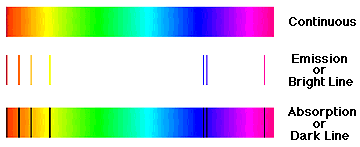
Caption: The formation of an emission line spectrum and an absorption line spectrum.
Features:
- The displayed spectra are in
image representation rather than in intensity
(which would be a plot of intensity
versus wavelength).
- The top band is a continuous spectrum
(e.g., a blackbody spectrum)
such as would be emitted by a dense source.
- The second band is
an emission line spectrum
such as would be emitted by a dilute gas.
The lines are the atomic spectral lines and/or molecular spectral lines.
The spectral lines are charateristcs of the particular atoms and/or molecules that make up the gas.
The study of line spectra---which is called spectroscopy---is overwhelmingly the most important form of chemical analysis.
You do NOT need a sample of the material. You just need light from the material.
It could come from your lab bench or from across the observable universe.
- The lines come from atomic transitions and/or
molecular transitions.
These transitions are changes in the internal state of atoms and molecules that lead to the emission or absorption of light.
The transitions are conventionally called lines.
-
There must be some name for the
figure of speech where something
is given the name of what it produces.
- The lower band is an
absorption line spectrum
such as you would get from
stars or collections of
stars (e.g.,
galaxies).
The atoms and/or molecules (including ionized atoms and molecules) in the low-density stellar atmosphere above the photosphere are colder (i.e., less excited) than the photosphere. They will absorb the photospheric emission in their lines.
- Thus, the lines
create dark lines that form an
absorption line spectrum.
For stars, such spectra are called stellar spectra.
- Recall, the photosphere
is the layer of a star
where the star becomes
sufficiently transparent that photons
can escape about half the time to infinity.
The photosphere produces a continuous spectrum that closely approximates a blackbody spectrum.
The photosphere is often called the surface of a star, but that is just convenient usage. Stars do NOT have sharp surfaces. Above the photosphere is the stellar atmosphere.
- Short explications of the formation of emission line spectra and absorption line spectra are given in the Spectroscopy videos below (local link / general link: spectroscopy_videos.html):
Image link: Itself.
Local file: local link: spectrum_formation.html.
File: Spectra file: spectrum_formation.html.